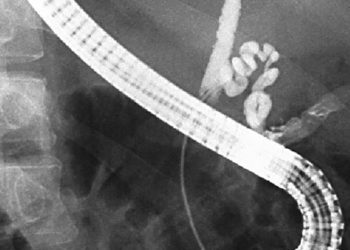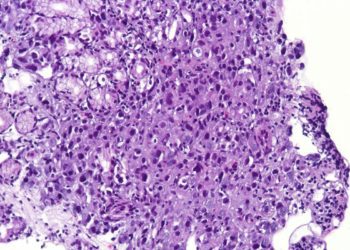Covered self-expanding metallic stents noninferior to plastic stents in benign biliary strictures
1. In this multicenter, open-label, noninferiority randomized trial, fully covered self-expanding metallic stents (cSEMS) were noninferior to conventional plastic stents for benign biliary stricture management, and required fewer ERCPs to achieve resolution.
2. This may allow for the benefits of stenting with fewer procedures required for benign biliary strictures if the cSEMS are used versus conventional plastic stents.
Evidence Rating Level: 1 (Excellent)
Study Rundown: Treating benign biliary strictures requires placement of multiple plastic stents via endoscopic retrograde cholangiopancreatography (ERCP) procedures. However, these stents are not placed at one time, and often 3 to 4 ERCPs are required, each with their own individual procedural risks. Placement of a single, fully covered, self-expanding metallic stent (cSEMS), performed during a single ERCP, may be equivalent in efficacy for treatment of benign biliary stricture and may also decrease the risk of serial ERCPs. This multicenter, open-label, noninferiority randomized controlled trial aimed to determine the utility of cSEMS for endoscopic treatment of benign biliary strictures.
The use of cSEMS was noninferior to multiple plastic stents in patients with benign biliary strictures with diameter ≥6mm in whom the metallic stent would not overlap the cystic duct. Mean number of ERCPs required for stricture resolution was lower in the cSEMS group. While this was a prospective randomized study to evaluate this clinical question, it was limited by its open-label design, which decreased the reliability of the results. Also, more than one ERCP was still required in the metallic stent group, when the goal was that only a single procedure would be required.
Click to read the study, published today in JAMA
Relevant Reading: Randomized multicenter study of multiple plastic stents vs. covered self-expandable metallic stent in the treatment of biliary stricture in chronic pancreatitis
In-Depth [randomized controlled trial]: This open-label, multicenter, parallel, randomized controlled trial was conducted at 8 regional referral centres for ERCP and liver transplantation in the USA and UK from April 2011 to September 2014. Patients with benign biliary strictures were included. Those with bile duct diameters less than 6mm above or below the stricture or in whom placement of cSEMS would overlap the cystic duct in the setting of an intact gallbladder were excluded. Patients were randomized to plastic stents or cSEMS stratified by etiology. Participants were followed at 12 months for stricture recurrence. The noninferiority margin was determined to be -15%.
The sample included 112 patients with benign biliary strictures, 55 patients in the plastic stent group and 57 patients in the cSEMS group. The resolution rate in the plastic stent group was 85.4% (41/48), and the rate for cSEMS was 92.6% (50 of 54 patients). This resulted in a rate difference of 7.2% (1-sided 95%CI -3.0% to ∞). With a noninferiority margin predefined as -15%, this showed that cSEMS were noninferior to plastic stents. The estimated median number of days to resolution was 225 days (95%CI 182-277) for plastic stent group and 181 days (95%CI 173-184) for the cSEMS group (p = 0.006). Fewer ERCPs were required to resolve strictures in patients randomized to cSEMS than plastic stents (mean 2.14 vs. 3.24, mean difference 1.10; 95%CI 0.74-1.46; p < 0.001). The number of adverse events per ERCP was not significantly different between groups.
Image: CC/Wiki
©2016 2 Minute Medicine, Inc. All rights reserved. No works may be reproduced without expressed written consent from 2 Minute Medicine, Inc. Inquire about licensing here. No article should be construed as medical advice and is not intended as such by the authors or by 2 Minute Medicine, Inc.







